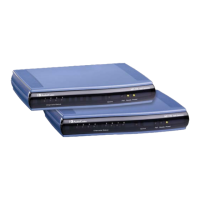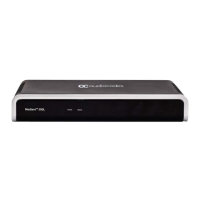Version 7.2 149 Mediant 1000B Gateway & E-SBC
User's Manual 12. Network
Parameter Description
[NATTranslation_SourceStartPort]
configured, the match is done on the entire port range. Only
IP addresses and ports of matched source ports will be
replaced.
Source End Port
src-end-port
[NATTranslation_SourceEndPort]
Defines the optional ending port range (1-65536) of the IP
interface, used as matching criteria for the NAT rule. If not
configured, the match is done on the entire port range. Only
IP addresses and ports of matched source ports will be
replaced.
Target
Target IP Address
target-ip-address
[NATTranslation_TargetIPAddress]
Defines the global (public) IP address. The device adds the
address in the outgoing packet to the SIP Via header,
Contact header, 'o=' SDP field, and 'c=' SDP field.
Target Start Port
target-start-port
[NATTranslation_TargetStartPort]
Defines the optional starting port range (1-65536) of the
global address. If not configured, the ports are not replaced.
Matching source ports are replaced with the target ports.
This address is set in the SIP Via and Contact headers and
in the 'o=' and 'c=' SDP fields.
Target End Port
target-end-port
[NATTranslation_TargetEndPort]
Defines the optional ending port range (1-65536) of the
global address. If not configured, the ports are not replaced.
Matching source ports are replaced with the target ports.
This address is set in the SIP Via and Contact headers and
in the 'o=' and 'c=' SDP fields.
12.7.2 Remote UA behind NAT
This section describes configuration for scenarios where the device sends signaling and
media packets to a remote UA that is located behind NAT.
12.7.2.1 SIP Signaling Messages
By default, the device resolves NAT issues for SIP signaling, using its NAT Detection
mechanism. The NAT Detection mechanism checks whether the endpoint is located behind
NAT by comparing the incoming packet's source IP address with the SIP Contact header's
IP address. If the packet's source IP address is a public address and the Contact header's
IP address is a local address, the device considers the endpoint as located behind NAT. In
this case, the device sends the SIP messages to the endpoint using the packet's source IP
address. Otherwise (or if you have disabled the NAT Detection mechanism), the device
sends the SIP messages according to the SIP standard (RFC 3261), where requests within
the SIP dialog are sent using the IP address in the Contact header, and responses to
INVITEs are sent using the IP address in the Via header.
If necessary, you can also configure the device to always consider incoming SIP INVITE
messages as sent from endpoints that are located behind NAT. When this is enabled, the
device sends responses to the INVITE (to the endpoint), using the the source IP address of
the packet (INVITE) initially received from the endpoint. This is useful in scenarios where
the endpoint is located behind a NAT firewall and the device (for whatever reason) is
unable to identify NAT using its regular NAT Detection mechanism. This feature is enabled
per specific calls using IP Groups. To configure this feature, use the 'Always Use Source
Address' parameter in the IP Groups table (see ''Configuring IP Groups'' on page 333). If

